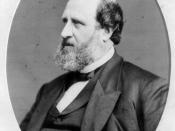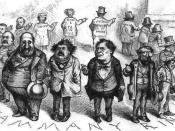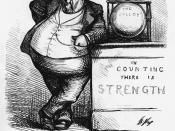The Original Boss
During the "Golden Years" of America, in the middle of the 19th century, it seemed as though nothing happened in New York City unless the Boss wanted it to happen. William Marcy "Boss" Tweed, a formidable politician, ruled and corrupted the city so shamelessly in the years right after the War Between the States, that his name became synonymous with dishonesty. Construction of the Brooklyn Bridge could not proceed until Tweed got a seat on the bridge company board. It was reported that he redirected more than $6 million of the city's money into his own bank account. Known among political reformers as the forty thieves, The Tweed Ring [Peter Sweeny, city chamberlain; Richard B. Connolly, city comptroller; and Oakey Hall, mayor (to name a few)], "sold" money-making franchises to companies they controlled, padded construction bills, practiced graft and extortion, and exploited every opportunity to plunder the city's funds, the Boss was a figure to be reckoned with.
Both beloved by many of the city's poor immigrants yet the target of pointed jabs from political cartoonist Thomas Nast, these were two opposite faces of the Boss.
There is little question that the Tweed Ring practiced thievery and that Tammany Hall had a series of reoccurring scandals. An estimated 75 to 200 million dollars were swindled from the City between 1865 and 1871. Yet, there is more to the story than a confrontation of the machine form of city government and the ideology of reformer exhortations. Tammany represented a form of organization that wedded the Democratic Party and the Society of St. Tammany (started in 1789 for patriotic and fraternal purposes) into an interchangeable exchange. The weave of city politics was the triangulation of the Mayor's office, the Democratic Party and the social club organization. During the...


